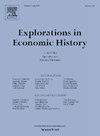纪念碑效应:重建后南方的邦联纪念碑
IF 1.7
1区 历史学
Q1 ECONOMICS
引用次数: 0
摘要
本文探讨了南方邦联纪念碑在后重建时期的同期效应。我将纪念碑、选举和人口普查数据结合起来,创建了 1878-1912 年间前邦联各县的选举年面板数据集,然后采用广义差分设计,利用纪念碑在时间上的交错和地理上的分布。我发现,纪念碑导致了民主党得票率的上升和投票率的下降,而黑人人口比例的下降则不太明显。我发现一些证据表明,纪念碑建设力度加大与黑人私刑的减少有关。我还发现,根据纪念碑的建造年代、建造纪念碑的强度以及纪念碑的特征,会产生不同的影响。为了解决潜在的机制问题,我提出了纪念碑与更多儿童使用著名的邦联名字有关的证据,并表明投票率的下降只发生在黑人人口比例较大的地区。总体而言,我的研究结果表明,纪念碑促进了对内战历史的歪曲,这种歪曲主要说服了南方白人,但也助长了对黑人的政治压制。这些发现对当前美国关于邦联纪念碑的争论具有启示意义。本文章由计算机程序翻译,如有差异,请以英文原文为准。
Monumental effects: Confederate monuments in the Post-Reconstruction South
This paper explores the contemporaneous effects of Confederate monuments dedicated in the Post-Reconstruction South. I combine monument, election, and census data to create an election-year panel dataset of former Confederate counties between 1878–1912, then exploit the temporally staggered and geographically distributed dedication of monuments using a generalized difference-in-differences design. I find that monuments caused increases in Democratic Party vote share and decreases in voter turnout, with less robust decreases in Black population share. I find some evidence that more intense monument-building is associated with a decrease in Black lynchings. I also find varying effects based on the era of monument dedication, the intensity of monument-building, and monument characteristics. To address potential mechanisms, I present evidence that monuments were associated with increased use of famous Confederate names for children and show that decreases in voter turnout occurred exclusively in areas with larger Black population shares. Overall, my results suggest monuments promoted a distorted view of Civil War history that primarily persuaded southern whites, but also contributed to Black political suppression. The findings have implications for current debates over Confederate monuments in the United States.
求助全文
通过发布文献求助,成功后即可免费获取论文全文。
去求助
来源期刊

Explorations in Economic History
Multiple-
CiteScore
2.50
自引率
8.70%
发文量
27
期刊介绍:
Explorations in Economic History provides broad coverage of the application of economic analysis to historical episodes. The journal has a tradition of innovative applications of theory and quantitative techniques, and it explores all aspects of economic change, all historical periods, all geographical locations, and all political and social systems. The journal includes papers by economists, economic historians, demographers, geographers, and sociologists. Explorations in Economic History is the only journal where you will find "Essays in Exploration." This unique department alerts economic historians to the potential in a new area of research, surveying the recent literature and then identifying the most promising issues to pursue.
 求助内容:
求助内容: 应助结果提醒方式:
应助结果提醒方式:


